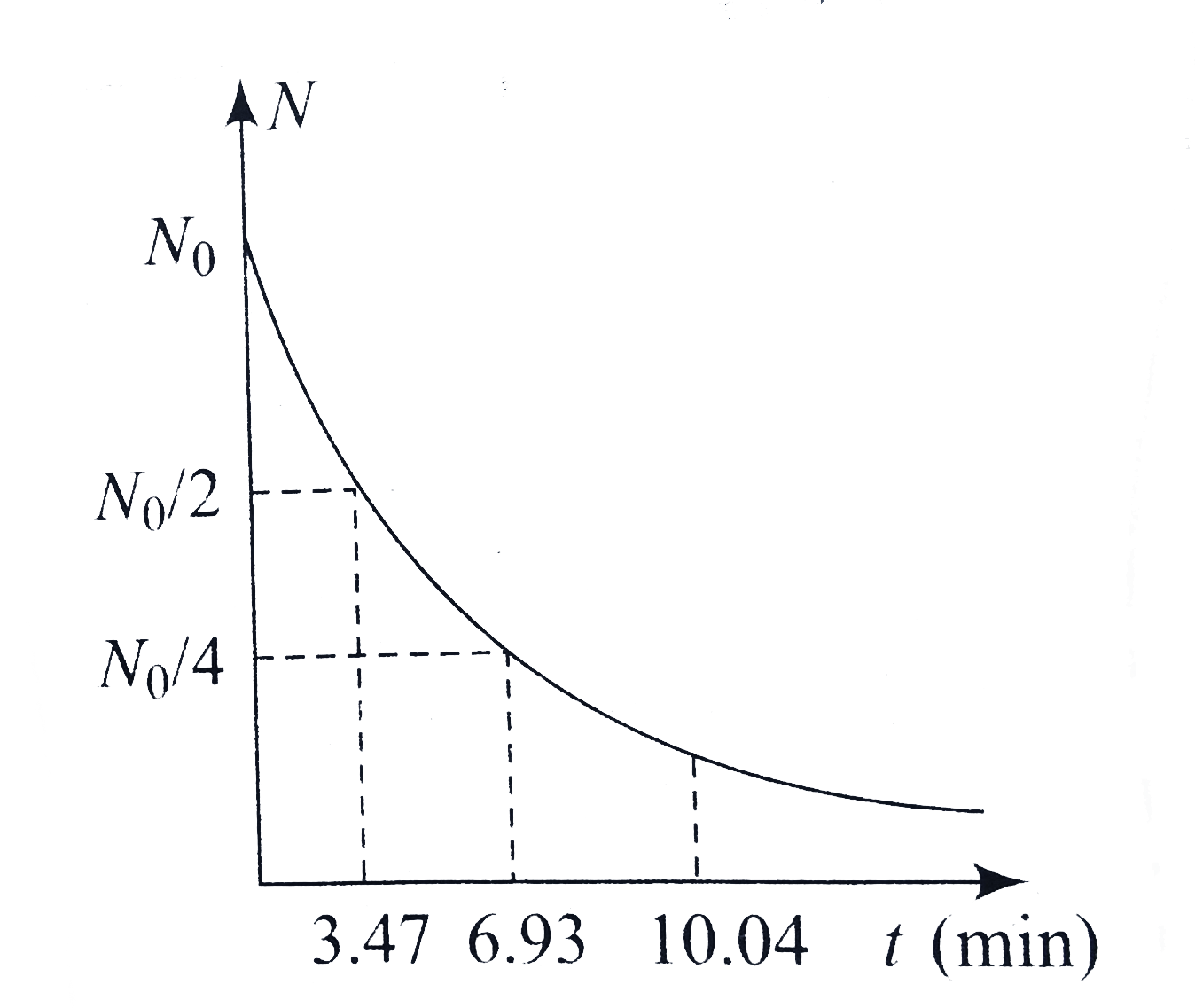A radio nuclide X is produced at constant rate α. At time t=0, number of nuclei of X are zero. Find
(a) the maximum number of nuclei of X.
the number of nuclei at time t.
Decay constant of X is λ.
The correct Answer is:A, B, D
To solve the problem step by step, we will break it down into two parts as requested: finding the maximum number of nuclei of X and finding the number of nuclei at time t.
Step 1: Finding the Maximum Number of Nuclei (N_max)
1. Understanding the Rates:
- The production rate of nuclei X is constant and given by α.
- The decay rate of nuclei X is proportional to the number of nuclei present and is given by λn, where n is the number of nuclei at time t.
2. Setting Up the Equation:
- At equilibrium (maximum number of nuclei), the rate of production equals the rate of decay:
α=λnmax
3. Solving for Maximum Nuclei:
- Rearranging the equation gives:
nmax=αλ
Step 2: Finding the Number of Nuclei at Time t (n(t))
1. Net Rate of Formation:
- The net rate of formation of nuclei X can be expressed as:
dndt=α−λn
2. Rearranging the Equation:
- We can rearrange this to separate variables:
dnα−λn=dt
3. Integrating Both Sides:
- We will integrate both sides. The left side will be integrated with respect to n from 0 to n, and the right side will be integrated with respect to t from 0 to t:
∫n01α−λndn=∫t0dt
4. Performing the Integration:
- The left side integrates to:
−1λln|α−λn|∣∣∣n0=t
- This leads to:
−1λ(ln|α−λn|−ln|α|)=t
5. Simplifying the Equation:
- This can be simplified to:
−1λln(α−λnα)=t
- Rearranging gives:
ln(α−λnα)=−λt
6. Exponentiating Both Sides:
- Exponentiating both sides leads to:
α−λnα=e−λt
7. Solving for n:
- Rearranging gives:
α−λn=αe−λt
- Thus:
λn=α−αe−λt
- Finally, solving for n:
n=αλ(1−e−λt)
Final Answers:
- (a) The maximum number of nuclei of X:
nmax=αλ
- (b) The number of nuclei at time t:
n(t)=αλ(1−e−λt)
- The production rate of nuclei X is constant and given by α.
- The decay rate of nuclei X is proportional to the number of nuclei present and is given by λn, where n is the number of nuclei at time t.
- At equilibrium (maximum number of nuclei), the rate of production equals the rate of decay:
α=λnmax
- Rearranging the equation gives:
nmax=αλ
- The net rate of formation of nuclei X can be expressed as:
dndt=α−λn
- We can rearrange this to separate variables:
dnα−λn=dt
- We will integrate both sides. The left side will be integrated with respect to n from 0 to n, and the right side will be integrated with respect to t from 0 to t:
∫n01α−λndn=∫t0dt
- The left side integrates to:
−1λln|α−λn|∣∣∣n0=t
- This leads to:
−1λ(ln|α−λn|−ln|α|)=t
- This can be simplified to:
−1λln(α−λnα)=t
- Rearranging gives:
ln(α−λnα)=−λt
- Exponentiating both sides leads to:
α−λnα=e−λt
- Rearranging gives:
α−λn=αe−λt
- Thus:
λn=α−αe−λt
- Finally, solving for n:
n=αλ(1−e−λt)
- (a) The maximum number of nuclei of X:
nmax=αλ
- (b) The number of nuclei at time t:
n(t)=αλ(1−e−λt)
Topper's Solved these Questions
- MODERN PHYSICS - 2Book:DC PANDEY ENGLISHChapter:MODERN PHYSICS - 2Exercise:Example Type 1
Explore 4 Videos
- MODERN PHYSICS - 2Book:DC PANDEY ENGLISHChapter:MODERN PHYSICS - 2Exercise:Example Type 2
Explore 4 Videos
- MODERN PHYSICS - 1Book:DC PANDEY ENGLISHChapter:MODERN PHYSICS - 1Exercise:Level 2 Subjective
Explore 23 Videos
- NUCLEIBook:DC PANDEY ENGLISHChapter:NUCLEIExercise:C MADICAL ENTRANCES GALLERY
Explore 46 Videos
Similar Questions
At time t=0 , number of nuclei of a radioactive substance are 100. At t=1 s these numbers become 90. Find the number of nuclei at t=2s.
View SolutionAt time t=0 , number of nuclei of a radioactive substance are 100. At t=1 s these numbers become 90. Find the number of nuclei at t=2s.
View SolutionA rodiactive nucleus is being produced at a constant rate α per second Its decay constant is λ If N0 are the number of nuclie at tieme t=O then, maximum number of nuclei possible are
View SolutionA radioacitve nucleus is being produced at a constant rate α per second. Its decay constant is λ. If N0 are the number of nuclei at time t=0, then maximum number of nuceli possible are .
View SolutionA factory produces a radioactive substance A at a constant rate R which decays with a decay constant λ to form a stable substance. Find (a) the number of nuclei of A and (b) number of nuclei of B, at any time t assuming the production of A starts at t=0. (c ) Also, find out the maximum number of nuclei of A present at any time during its formation.
View SolutionNumber of nuclei of a radioactive substance are 1000 and 900 at times t=0 and time t=2s. Then, number of nuclei at time t=4s will be
View SolutionA radioactive substance (A) is produced at a constant rate which decays with a decay constant λ to form stable substance (B).If production of A starts at t=0 . Find (i)The number of nuclei of A and (ii)Number of nuclei of B at any time t.
View SolutionNuclei of a radioactive element A are being produced at a constant rate α. The element has a decay constant λ. At time t=0, there are N0 nuclei of the element.
(a) Calculate the number N of nuclei of A at time t.
(b) If α=2N0λ, calculate the number of nuclei of A after one half-life of A, and also the limiting value of N as t→∞.
View SolutionA radioactive nuclide is produced at the constant rate of n per second (say, by bombarding a target with neutrons). The expected number N of nuclei in existence t s after the number is N0 is given by
View SolutionA radioactive sample undergoes decay as per the following gragp. At timet=0, the number of undecayed nuclei is N0. Calculate the number of nuclei left after 1h.
 .
.
View Solution

